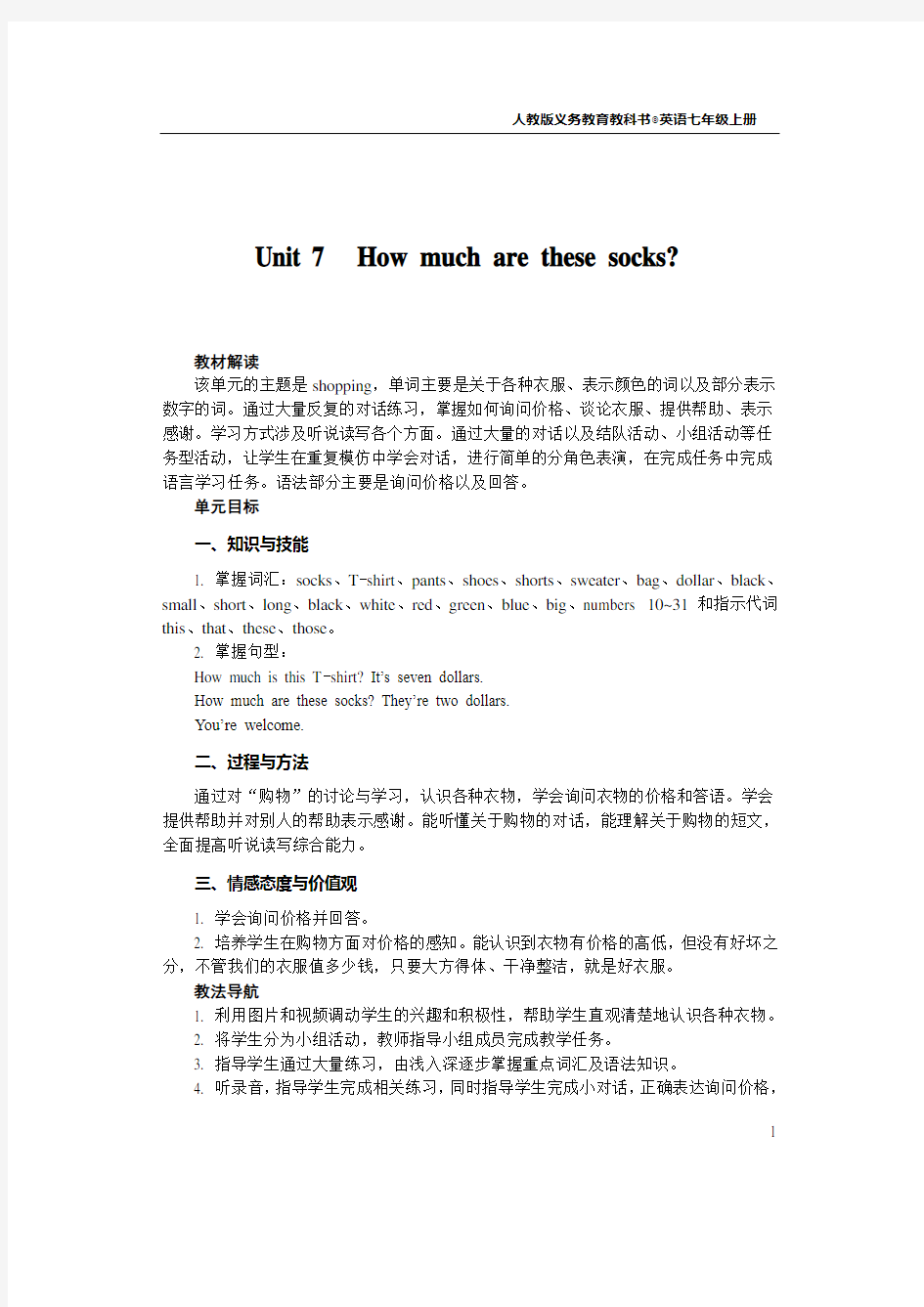

Unit 7 How much are these socks?
教材解读
该单元的主题是shopping,单词主要是关于各种衣服、表示颜色的词以及部分表示数字的词。通过大量反复的对话练习,掌握如何询问价格、谈论衣服、提供帮助、表示感谢。学习方式涉及听说读写各个方面。通过大量的对话以及结队活动、小组活动等任务型活动,让学生在重复模仿中学会对话,进行简单的分角色表演,在完成任务中完成语言学习任务。语法部分主要是询问价格以及回答。
单元目标
一、知识与技能
1. 掌握词汇:socks、T-shirt、pants、shoes、shorts、sweater、bag、dollar、black、small、short、long、black、white、red、green、blue、big、numbers 10~31和指示代词this、that、these、those。
2. 掌握句型:
How much is this T-shirt? It’s seven dollars.
How much are these socks? They’re two dollars.
You’re welcome.
二、过程与方法
通过对“购物”的讨论与学习,认识各种衣物,学会询问衣物的价格和答语。学会提供帮助并对别人的帮助表示感谢。能听懂关于购物的对话,能理解关于购物的短文,全面提高听说读写综合能力。
三、情感态度与价值观
1. 学会询问价格并回答。
2. 培养学生在购物方面对价格的感知。能认识到衣物有价格的高低,但没有好坏之分,不管我们的衣服值多少钱,只要大方得体、干净整洁,就是好衣服。
教法导航
1. 利用图片和视频调动学生的兴趣和积极性,帮助学生直观清楚地认识各种衣物。
2. 将学生分为小组活动,教师指导小组成员完成教学任务。
3. 指导学生通过大量练习,由浅入深逐步掌握重点词汇及语法知识。
4. 听录音,指导学生完成相关练习,同时指导学生完成小对话,正确表达询问价格,
1
回答,提供帮助,感谢他人。
学法导航
1. 认真听,努力提高听力。
2. 积极编写对话并表演出来,培养写作和口语表达能力。
3. 积极开展小组活动,争取组内解决大部分问题。
4. 认真查找,搜集资料,为写作和表演打好基础。
课时支配
第1课时:Section A 1a-2d
第2课时:Section A 2e-3c
第3课时:Section B 1a-2a
第4课时:Section B 2b-Self Check
课时教案
第1课时Section A1a-2d
教学目标
一、知识与技能
1. 掌握词汇:socks、T-shirt、shorts、sweater、bag、hat、trousers、shoes、jacket、skirt、black、white、red、green、blue、big、small、short、long。
2. 掌握句型:
How much is this T-shirt? It’s seven dollars.
How much are these socks? They’re two dollars.
二、过程与方法
1. 通过搜集资料,了解并小组讨论各种衣物。
2. 讨论衣服的价格。
三、情感态度与价值观
1. 学会询问价格并回答。
2. 培养学生在购物方面对价格的感知。
教学重点
掌握目标词汇和重点句子。
教学难点
初步掌握询问价格的句型和答语。
教法导航
通过图片和实物,了解我们日常所见的衣物。
2
学法导航
小组活动讨论各种衣物、颜色和价格。
教学准备
图片、实物、多媒体等。
教学过程
Step 1: Greetings
Greet the students as usual.
Step 2: Lead in
T:Hello, everyone! Do you like shopping?
Ss:Yes, we do.
T:Do you know the names of the clothes?
Ss:Sorry, we don’t know.
T:That’s all right. This class we will learn the names of the clothes.
Step 3: New words
Show the names of the clothes with pictures or some clothes and ask:
T:What’s this?Ss:It’s a/an ...
T:What are these? Ss:They’re ...
T:Is this a ...? Ss:...
T:Are they ...? Ss:...
Step 4: Practice
Work on 1a Match the words with the pictures.
Work on 1b Listen and circle the things in the picture you hear.
Step 5: Enjoy your English
Watch a play. Listen carefully and let’s find out how to ask prices.
Step 6: Pair work
Get the students to work in pairs:
A:How much is this T-shirt?
B:It’s seven dollars.
A:How much are these socks?
B:They’re two dollars.
Step 7: Sing a song
T:Boys and girls. Do you like songs?
Ss:Yes, we like songs very much.
T:Now I have a beautiful color song for you. Let’s learn to sing it. Ok?
Ss:Ok.
Watch the play and sing the color song.
Step 8: New words
Show some pictures of clothes of different colors and ask:
T:What is this? Ss:It’s a hat.
3
T:What color is it ? Ss:It’s red.
T:It’s a red hat, isn’t it? S s:Yes, it is a red hat.
Step 9: Practice
1.Say the colors in our classroom and try to describe the things in the picture such as a red flag.
2.Find out three opposite in the new words:black/white, big/small, short/long.
Step 10: Listening
Work on 2a Listen and repeat.
Work on 2b Listen to the conversations and circle the things you hear.
Work on 2c Listen again. Fill in the price tags.
Step 11: Presentation
Work on 2d Ask and answer the questions about the things in 2b.
A:I like these shorts. How much are they?
B:They’re six dollar s.
Step 12: Homework
1.Look at Meimei Clothing Store and ask the prices with your partners.
2.Find five more clothing names and write them down on your workbook.
3.Please find out five more kinds of color and write their English names on your workbook.
课堂作业
在第Ⅰ栏中用is this或are these填空;在第Ⅱ栏中用It’s或They’re填空。
ⅠⅡ
1.How much T-shirt? 5 dollars.
2.How much skirt? 7 dollars.
3.How much shorts? 9 dollars.
4.How much sweater? 10 dollars.
5.How much pants? 6 dollars.
6.How much shoes? 8 dollars.
参考答案:
1. is this, It’s
2. is this, It’s
3. are these, They’re
4. is this, It’s
5. are these, They’re
6. are these, They’re
教学反思
本课内容是关于购物的,围绕学生的生活实际,又加之内容较简单,所以学生学起来得心应手,表现出极大的兴趣,说明语言来源于生活。
4
5